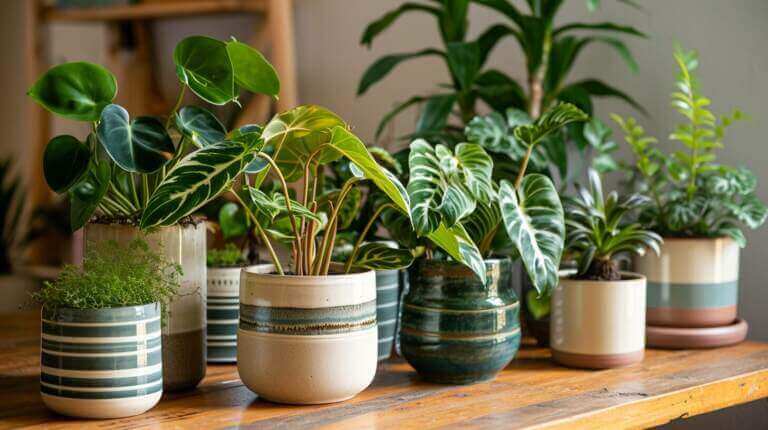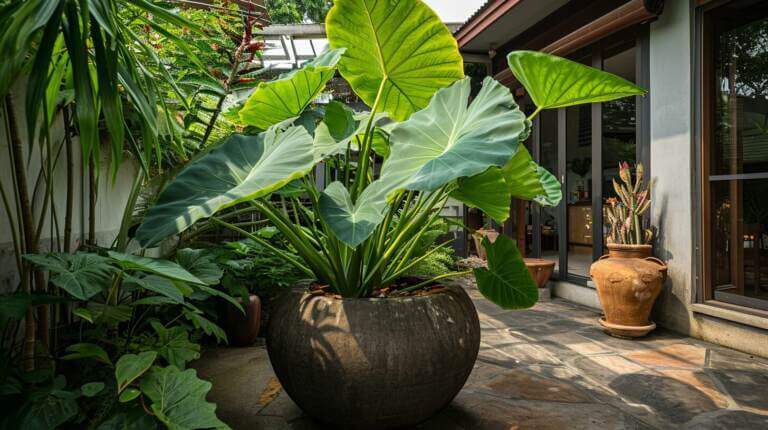Growing Stunning Calathea Varieties as Houseplants
The genus Calathea includes some of the most beautiful tropical plants in the world, known for their boldly marked, oblong leaves in a dazzling array of colors. Calatheas prayer plant are often called zebra plants, peacock plants, or rattlesnake plants due to their eye-catching stripes and veining. They are popular as houseplants because of their stunning foliage. Calatheas require specific care, including filtered light, consistent moisture, and high humidity. They prefer a loamy or humusy soil with a slightly acidic to neutral pH. Calatheas can be grown from seeds or propagated through root division. There are many varieties of calatheas to choose from, each with its own unique pattern and color.
Key Takeaways:
- Growing stunning tropical calathea varieties as houseplants requires specific care, including filtered light, consistent moisture, and high humidity.
- Calatheas prefer a loamy or humusy soil with a slightly acidic to neutral pH.
- Calatheas can be grown from seeds or propagated through root division.
- There are many unique varieties of calatheas to choose from, each with its own distinct pattern and color.
- Adding calatheas to your indoor plant collection can bring a touch of tropical beauty to your home.
Care Tips For Calathea Plant
When it comes to caring for calatheas, there are a few key factors to keep in mind to ensure their health and vitality. Here are some essential care tips and plant needs for your calathea:
1. Light:
Calatheas thrive in indirect light or shade. Exposure to direct sunlight can burn their delicate leaves, so it’s best to place them in a location with filtered light. This could be near a north or east-facing window where they can receive bright, indirect light throughout the day.
2. Water:
Consistent moisture is crucial for calatheas, but they don’t want to be waterlogged. It’s important to keep the soil slightly moist by watering them when the top inch of soil feels dry to the touch. Use filtered or distilled water, as calatheas are sensitive to the minerals found in tap water.
3. Humidity:
Calatheas love high humidity, which mimics their natural tropical habitat. You can increase humidity levels by misting the leaves with water or placing the pot on a tray filled with water and pebbles. As the water evaporates, it creates a humid microclimate around the plant.
4. Temperature:
Calatheas thrive in temperatures between 70 and 85 degrees Fahrenheit (21 to 29 degrees Celsius). Avoid exposing them to cold drafts or sudden temperature fluctuations, as they are sensitive to extreme temperature changes.
| Light | Water | Humidity | Temperature |
|---|---|---|---|
| Indirect light or shade | Keep soil slightly moist | High humidity | 70-85°F (21-29°C) |
By following these care tips and providing the right conditions for your calathea, you can enjoy their stunning foliage and watch them thrive in your indoor space.
Different Calathea Varieties
Calatheas are known for their stunning foliage and come in a wide variety of patterns and colors. Here are some of the popular calathea varieties:
Calathea Orbifolia
Characterized by its silver-green stripes, Calathea Orbifolia is a visually striking variety that adds a touch of elegance to any space.
Calathea Makoyana
The Calathea Makoyana, also known as the peacock plant, features dark green leaves with cream, purple, and pink patterns. Its vibrant colors make it a favorite among plant enthusiasts.
Calathea Ornata
The Calathea Ornata, also called the pinstripe plant, has deep green leaves adorned with beautiful pink stripes. This variety brings a touch of sophistication and style to any indoor setting.
Calathea Zebrina
With its distinctive zebra-like patterns, the Calathea Zebrina is a unique variety that is sure to catch the eye. Its bold foliage adds a touch of exotic flair to any collection.
Calathea Lancifolia
The Calathea Lancifolia, also known as the rattlesnake plant, features long, lance-shaped leaves with dark green patterns. Its unique markings make it a popular choice among plant enthusiasts.
Calathea Roseopicta
The Calathea Roseopicta, also called the rose-painted calathea, is known for its stunning rose-colored patterns on deep green leaves. This variety adds a touch of beauty and charm to any space.
Calathea Crocata
Characterized by its vibrant orange flowers, the Calathea Crocata brings a burst of color and beauty to any indoor garden. It is a showstopper that demands attention.
Calathea Rufibarba
The Calathea Rufibarba, also known as the velvet calathea, features soft, velvety leaves in shades of green. Its unique texture adds a touch of tactile interest to any collection.
Calathea Warscewiczii
The Calathea Warscewiczii, also called the jungle velvet calathea, has large, velvety leaves with a dark purple underside. Its dramatic foliage makes it a standout in any space.
Calathea Albertii
The Calathea Albertii, also known as the silver calathea, is characterized by its silver-green leaves with dark green stripes. Its unique coloration adds a touch of elegance and sophistication to any setting.
These are just a few examples of the many stunning calathea varieties available. Each one offers its own unique pattern and color, allowing you to find the perfect calathea to suit your personal taste and style.
How to Propagate and Grow Calathea Indoor Plant
Propagating calatheas is a great way to expand your collection or share these beautiful plants with friends and family. There are two main methods of propagation: root division and starting from seeds.
Root Division: Root division is best done in the spring when the plant is actively growing. Carefully remove the plant from its pot and gently separate the roots into smaller sections. Each section should have a healthy root system and a few leaves. Replant each section in a fresh pot with well-draining soil, making sure to keep the roots at the same depth as they were before. Water the newly divided plants thoroughly and place them in a warm and humid location. With proper care, the divided calatheas should start to grow and establish themselves in their new pots.
Starting from Seeds: If you prefer to start calatheas from seeds, it’s best to do so in early spring. Fill a seed tray or small pots with a seed-starting mix and press the seeds lightly into the soil. Cover the tray or pots with clear plastic wrap to create a mini greenhouse effect and maintain humidity. Place the tray or pots in a warm location with indirect light. Keep the soil consistently moist but not waterlogged. Germination usually takes around two to four weeks, and once the seedlings have several leaves, they can be transplanted into individual pots with well-draining soil.
Propagation Tips:
- When dividing calatheas, use a sharp and clean knife or garden shears to minimize damage to the roots.
- Choose mature plants with multiple stems for root division as they are more likely to survive the process.
- When starting from seeds, make sure to keep the soil consistently moist and provide the seedlings with a warm and humid environment.
- Patience is key when propagating calatheas. It may take some time for the new plants to establish and start growing.
Tips for Choosing the Right Pot and Repotting Calatheas
Choosing the right pot for your calathea is crucial for its growth and overall health. The size and materials of the pot can greatly affect how well your plant thrives. An ideal pot for a calathea should have a diameter of 8 to 10 inches and should be equipped with ample drainage holes to prevent waterlogging. While there are various pot materials available, unglazed clay pots are highly recommended as they allow excess soil moisture to evaporate, preventing root rot.
When repotting your calathea, it’s important to do so every few years in the spring or early summer. This helps to refresh the soil and give the plant more room to grow. Choose a slightly larger pot with fresh, well-draining potting mix. Before repotting, water the plant thoroughly to ensure the rootball can be safely removed from the old pot. When removing the plant, be gentle and try to keep the roots intact as much as possible.
In order to ensure successful repotting, follow these repotting tips:
- Handle the plant with care to avoid damaging the leaves or roots.
- Choose a pot that provides enough space for the plant to grow, but not too large to prevent excessive moisture retention.
- Use a well-draining potting mix that is specifically formulated for houseplants.
- Water the plant thoroughly before repotting to minimize stress on the roots.
- Gently loosen the rootball and remove any damaged or rotting roots.
- Place the plant in the new pot, ensuring it is centered and at the same depth as before.
- Fill the remaining space with fresh potting mix and gently press it down to secure the plant.
- Water the plant lightly after repotting and continue with regular care.
By choosing the right pot and following proper repotting techniques, you can provide your calathea with an optimal environment for growth, ensuring it remains healthy and vibrant for years to come.
| Potting Tips | Key Takeaways |
|---|---|
| Choose a pot with drainage holes | Prevents waterlogging and root rot |
| Opt for unglazed clay pots | Allows excess moisture to evaporate |
| Repot every few years in spring or early summer | Refreshes soil and provides more space for growth |
| Handle the plant with care during repotting | Avoids damage to leaves and roots |
| Choose a slightly larger pot | Provides room for growth without excess moisture retention |
| Use well-draining potting mix | Ensures proper water flow and prevents waterlogging |
| Water the plant thoroughly before repotting | Minimizes stress on the roots during the process |
| Loosen the rootball and remove damaged roots | Promotes healthy root development |
| Center the plant in the new pot at the same depth | Provides stability and proper nutrient absorption |
| Fill remaining space with fresh potting mix | Supports root development and nutrient uptake |
Following these tips will help you ensure the well-being of your calathea plant and create an optimal environment for its growth. By choosing the right pot and properly repotting your calathea, you can enjoy its stunning foliage and vibrant colors as it thrives in your home.
Outdoors Calathea Care
Calatheas can bring a touch of tropical beauty to outdoor spaces during the summer months. However, they require specific care to thrive in an outdoor environment. Here are some essential tips for taking care of calatheas outdoors:
Protect from Extreme Temperatures
Calatheas are tropical plants that prefer temperatures between 60 and 85 degrees Fahrenheit. Avoid exposing them to extremely hot or cold temperatures, as it can cause stress and damage to the plants. If the temperature drops below 60 degrees Fahrenheit, it’s best to bring them indoors to protect them from the cold.
Provide Filtered Light
Just like when growing indoors, calatheas outdoors prefer filtered light or shade. Direct sunlight can scorch their delicate leaves, so it’s important to place them in a location where they receive bright, indirect light or dappled shade. Consider placing them under the canopy of a tree or on a covered patio.
Prevent Pest Infestations
When moving your calatheas outdoors, it’s crucial to check them for any signs of pests. Common garden pests such as aphids, mealybugs, and spider mites can infest calatheas and cause damage. Treat any infestations promptly with organic insecticidal soap or neem oil to keep your plants healthy.
| Outdoor Care Tips for Calatheas |
|---|
| Protect plants from extreme temperatures |
| Provide filtered light or shade |
| Check for pests and treat infestations |
By following these outdoor care tips, you can enjoy the vibrant beauty of calatheas in your garden or patio during the warm summer months. However, remember to bring them indoors when temperatures drop or if extreme weather conditions are expected.
Troubleshooting Common Calathea Problems
As beautiful as calatheas are, they can sometimes face common issues that can affect their overall health and appearance. Here are some common calathea problems and how to address them:
One of the most common problems with calatheas is browning or yellowing leaves. This can be a sign of watering issues. Calatheas like to have consistently moist soil, but overwatering can lead to root rot and browning leaves. On the other hand, underwatering can cause yellowing and dryness. To remedy this, make sure to water your calathea regularly, keeping the soil moist but not soggy.
Another issue to watch out for is sunlight. Calatheas are shade-loving plants and cannot tolerate direct sunlight. If exposed to too much sun, their leaves can get sunburned and turn brown. To prevent this, place your calathea in an area with filtered or indirect light, away from windows or direct sunlight.
Pests can also pose a threat to your calathea’s health. Common pests that can affect calatheas include red spider mites, aphids, mealybugs, and scale. If you notice any signs of infestation, such as tiny webs or sticky residue on the leaves, it’s important to take action. Treat the affected plants with horticultural oil or insecticidal soap to eliminate the pests and protect your calathea.
FAQ
Are calathea plants tropical?
Yes, calatheas are tropical plants. They are native to the tropical Americas and prefer conditions that mimic their native environment, with high humidity and warm temperatures.
How do I propagate a calathea plant?
Calathea propagation is usually done by division. This involves removing the plant from its pot, gently dividing the plant at the roots, and repotting the divisions. This is best done during the growing season.
How do I grow and care for different calathea varieties?
While all calatheas have similar care requirements, different varieties might have specific needs. For example, some varieties might prefer slightly more humidity or less direct light. Always research the specific care tips for your calathea variety to ensure it thrives.
What is a prayer plant and how is it related to Calathea?
The term “prayer plant” is commonly used to refer to the Calathea genus, which includes many varieties of Calathea. These plants are known as prayer plants because their leaves fold up at night, similar to hands in prayer.
Can you provide some Calathea care tips?
To keep your Calathea healthy, ensure it has indirect light, high humidity, and warm temperatures. Avoid excess water as it can lead to root rot.
Can Calathea be grown as a houseplant?
Yes, Calathea is a popular houseplant due to its beautiful foliage. However, it can be difficult to care for as it has specific plant care needs.
What is a zebra plant?
The zebra plant, also known as Calathea zebrina, is a variety of Calathea with striking light green and dark green striped leaves, resembling a zebra’s stripes.
How many species of Calathea are there?
There are many species of Calathea. Some of the popular ones include Calathea veitchiana, Calathea freddie, and Calathea lutea.
How to care for Calatheas?
Care for Calathea plants involves providing them with high humidity, indirect light, and warm temperatures. They also prefer well-draining soil and should be watered when the top inch of soil is dry.
What are some common problems with Calathea?
Some common problems with Calathea include brown leaf tips, curling leaves, and wilting. These are often caused by environmental factors such as low humidity, overwatering, or insufficient light.







